Let’s face it, as much as the grumbling of a straight pipe exhaust can get exciting for most motorheads, it can get expensive pretty fast. Achieving that desirable sound with your car sometimes means spending a load of cash on the best supercharger and turbocharger. But if you are looking for a quick fix, the best exhaust pipe cutter will easily slice through the pipe of your exhaust system whenever you need to replace it with a straight pipe exhaust that turns heads.
Apart from enabling your car to produce loud strange noises, using an exhaust pipe cutter can also increase the performance of your car’s horsepower. Cutting your car’s exhaust pipe can allow for better exhaust flow and eventually better engine torque. Exhaust pipe cutters are designed for speed and safety making them ideal for both DIYers and professional mechanics.
Whatever your goal for cutting your tailpipe might be, here are some of the top factors to keep in mind while buying an exhaust pipe cutter.
Features to Consider in Good Exhaust Pipe Cutters
Power Source
Different exhaust pipe cutters are powered differently. You can have an exhaust pipe cutter that is powered by electricity or one that is powered by a hydraulic system or even manually. While picking an exhaust pipe cutter, consider the source of power that best fits your budget and your needs. If you are planning to cut a full exhaust pipe, you will need an exhaust pipe cutter that has sufficient power. For such a case, we recommend going with an electrical exhaust pipe cutter or one that is powered by a hydraulic system. Electric and hydraulic sources of power are way more capable of handling heavy duty exhaust commercial cutting tasks. You can go with a manually powered exhaust cutter if the task at hand is lightweight or if you have more time on your hands. However, some manual tools are well capable to cut through tough steel quickly.
Adjustability
The adjustability of an exhaust pipe cutter is another important feature you have to pay attention to while making a purchase. One of the best adjustability features to look out for in an exhaust pipe cutter is the reamer and the handle. The reamer or the cutting wheel is a precision cutting feature that allows you to have neat and professional cuts on your exhaust pipes. Basically, a chain wheel will leave behind clean cuts with a limited amount of metal fillings. Ultimately, you should aim for an adjustable pipe cutter with a cutting wheel that can accommodate exhaust pipes of different sizes as well.
Cutting speed
Next factor to have in mind is the cutting speed of your exhaust pipe cutter. Normally cutting through your exhaust pipe (especially if you are using a manual exhaust pipe cutter) might take some time. The process requires that you make repeated twists with the cutter around the exhaust pipe. You need to start slow to make sure the pipe cutter goes through the metal with a clean cut. If you are a DIYer at home, you might want to take your time to get a decent cut on your exhaust pipe. However, for professionals working with busty clients, the best option for fast cutting is an electric or hydraulic powered pipe cutter. Also, check to see whether the blades on the cutter are sharp enough for speedy cutting.
User-friendly features
As a DIYer or even a professional, getting a user-friendly tool is a plus towards increasing your productivity. For that reason, we recommend going with an exhaust pipe cutter that has user-friendly features. In general, this includes features that reduce the amount of energy you have to exert to get the job done. Another aspect to check out in order to pick a user-friendly tool is the handle. The handle needs to have a solid and comfortable grip that allows you to get through the job fast and easily. The handle should also be robust enough to protect your fingers from injury. Be sure to also check for other safety features since exhaust pipe cutters can be dangerous if handled without care.
Top 10 Best Exhaust Pipe Cutters 2020
1. OEMTOOLS 27045 Tailpipe Cutter
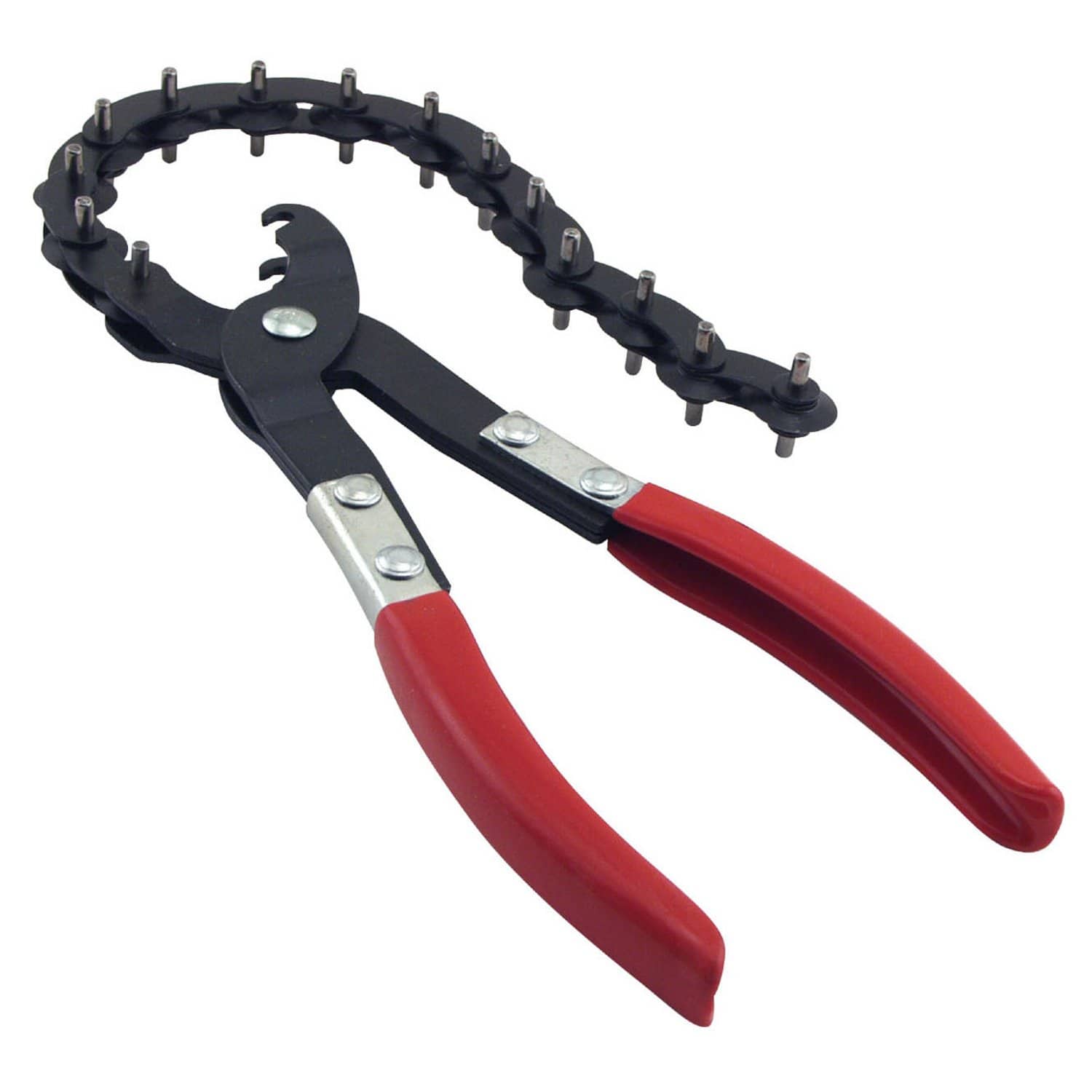

Editor’s Rating:
Features
If you are looking for an exhaust pipe cutter sufficient for accessing pipes in small tight space, the OEMTOOLS 27045 Tailpipe Cutter makes up a decent pick. It comes with a 3/4-Inch to 3-1/4-Inch diameter range making it a decent fit for getting the job done with standard exhaust pipes.
This is a durable tailpipe cutter that features sharp steel blades that will last through heavy-duty tasks as well as cut through a 3-inch stainless steel pipe.
Each roller comes with a hardened steel blade that enables this tool to cut smoothly through any exhaust pipe. This design also allows for smooth tracking which is great for achieving speed with your cuts.
With a 5/8 inch chain, you can easily make a snap around the pipe even in tight spaces. Plus the handle is with a cushion grip for comfort and it only needs a 90-degree motion to cut. This means you can achieve precise cutting in spaces such as between the fender and gas tank.
Holding up the blades are a set of press-fit pins that are easily replaceable in case you ever need to replace the blades if they get blunt. As long as you remember to oil it every once in a while and sharpen the blades, this tail cutter will serve for a long time without failure.
Verdict
If you need a reliable tool that will help you cut through your exhaust pipe, this unit makes up a decent choice. It comes with a comfortable grip that only requires a 90-degree motion to cut. This makes it a must-have for mechanics and DIYers working on projects that require fitting in small space.
Pros
- Reliable performance
- Durable quality
- Hardened steel blades
- Comfortable grip
Cons
- Requires lubrication
2. GEARWRENCH 2031DD Exhaust and Tailpipe Cutter
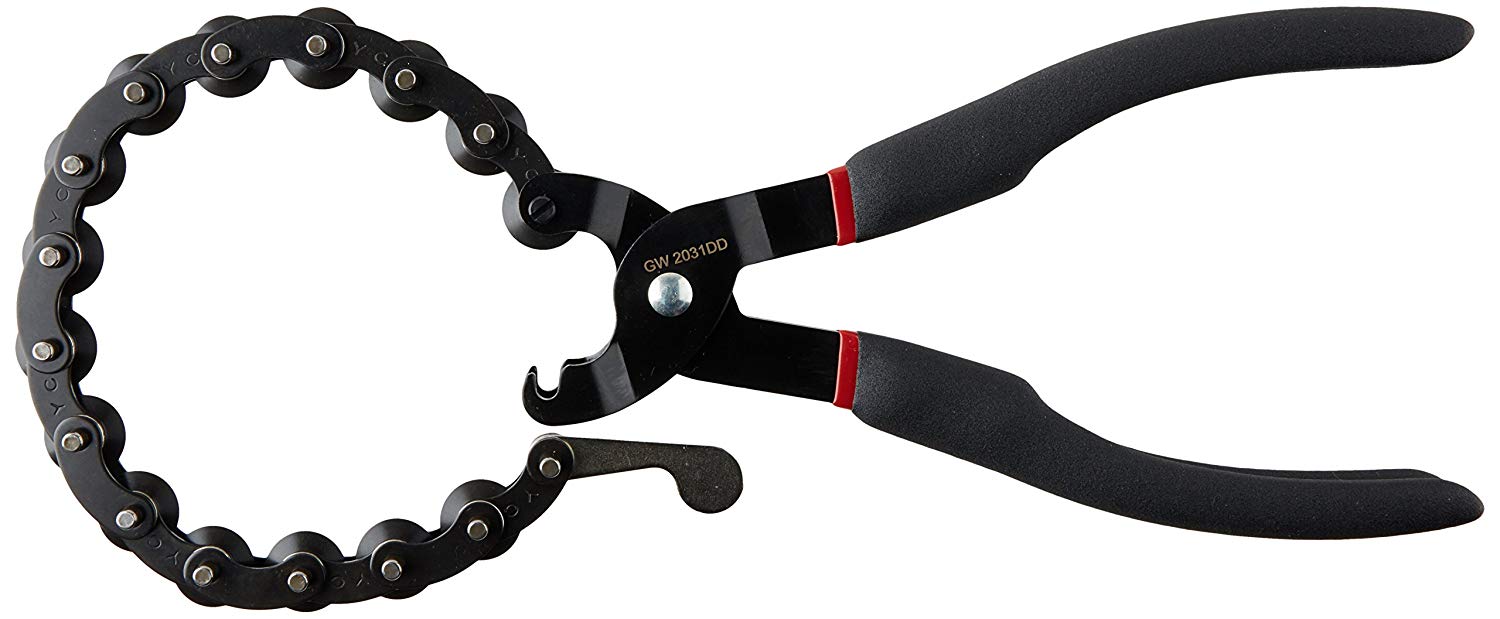

Editor’s Rating:
Features
This pipe cutter from GearWrench is designed for effortless cutting with minimal effort. Even though it cannot be used on stainless steel pipes, it boasts of 15 blades for effective cutting. It also comes with an easy grip thanks to the design of the handle.
Just like the OEMTOOLS 27045 Tailpipe Cutter, this tool can be used to reach and cut pipes in tight spaces. In fact, with its lightweight build that only measures 1.16pounds, this tailpipe cutter can be used for hours without fatigue. It also comes with a ¾ inch to 3-inch pipe diameter range making it ideal for cutting through thin-walled pipes.
For a smooth cut, the 15 blades perform incredibly well. The only possible downside is that even though the blades are super sharp, they tend to get blunt easily. However, with proper maintenance and oiling, this will hardly be a problem.
Verdict
Even though this tailpipe cutter cannot be used on stainless steel pipes or on double wall pipes, it performs well for a tool at its price range. It is durable and the 15 blade design performs well for effortless cutting. If you need a unit that is also easy to use especially in tight small spaces, this tool from GearWrench makes a perfect fit.
Pros
- Effective cutting with 15 blades
- Lightweight body for comfort
- Comfortable grip
- Ideal for hard to reach spaces
Cons
- Not the best for double walled pipes
- It cannot be used on stainless steel pipes
3. Exhaust Cutting Metal Pipe / Tube Chain Cutter
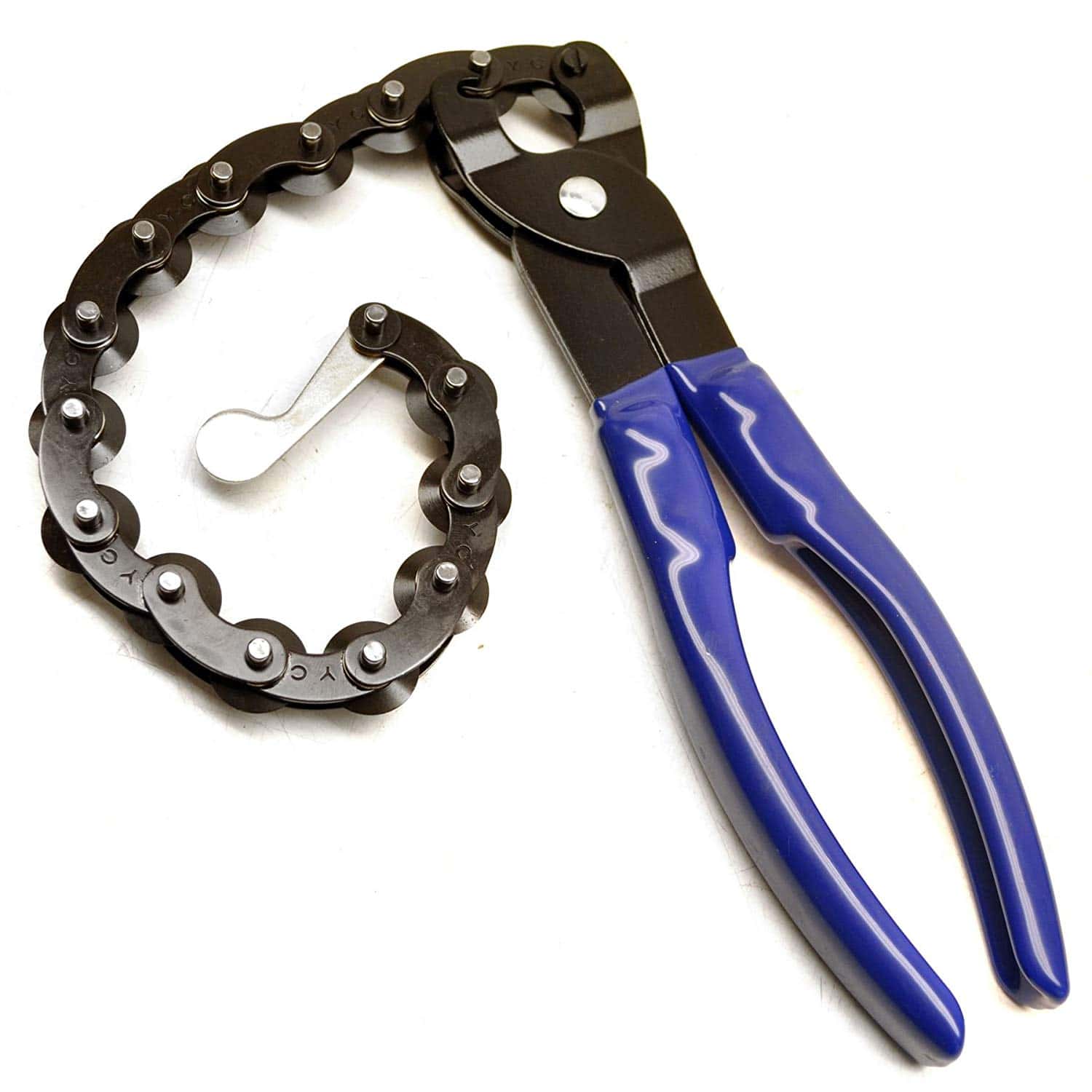

Editor’s Rating:
Features
If you are searching for a pipe cutter that will serve you well through your DIY projects, this unit is one you do not want to miss. It comes with a capacity to cut through pipes as thick as 3mm with a diameter in the ¾ inch to 3-1/4 inch range.
If your car’s exhaust pipe is made of stainless steel, aluminum, or galvanized steel, this tailpipe cutter will be enough to get the job done. It comes with multiple wheels on its chain that gives it a capacity for fast cutting. In fact, you will only need a ¼ inch turn for a complete cut giving you the convenience of applying a small amount of effort for big cuts.
When it comes to jobs that require you to reach out and cut pipes in tight and hard to reach places, this pipe cutter will perform much better than regular tools that can’t get into restricted areas. Thanks to the fact that the new diameter wheel pivots for smooth tracking, you can pretty much achieve clean cuts with ease.
The cushioned grip makes cutting even easier since you get a solid grip for comfort and speed. Simply put, you can use the pipe cutter for hours of work without fatigue.
Verdict
Whether you are a DIYer or a mechanic looking to make cuts on your car’s exhaust pipe, this tailpipe cutter will do the job that a hack saw simply won’t accomplish.
It leaves behind clean cuts without the risks of injury due to flying hot pieces of residue metal. Plus, it is made with a specially hardened material that can cut through pipes as thick as 3mm.
You might, however; want to start with slow to get easy cuts for the best results. The only complaint so far is that its blades got blunt after about 20 cuts. This means you cannot use it multiple times without oiling the wheels or sharpening the blades.
Pros
- Hardened steel design for effective cutting through steel
- Adjustable diameter
- Comes with a cushioned grip for comfort
- Requires about ¼ inch turn for a complete cut
- Capable of cutting pipes in tight spaces
Cons
- Blades get dull after 20 cuts
- Requires regular oiling
4. APSG Exhaust Tail Pipe Cutter
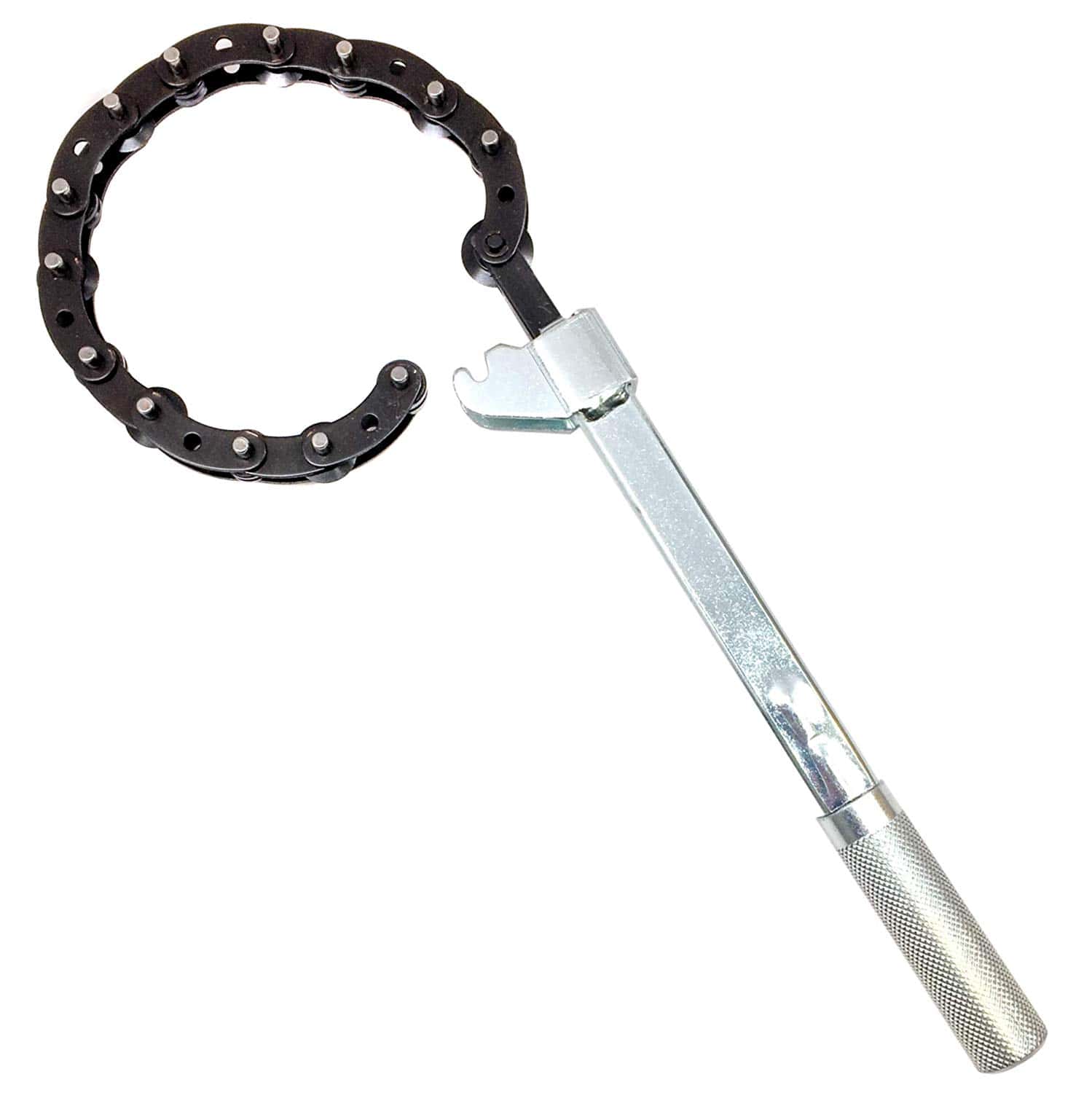

Editor’s Rating:
Features
Adjustability and a capacity to cut pipes in hard to reach areas are one of the main considerations for any DIYer or mechanic looking for a vehicle exhaust pipe cutter. This pipe cutter from APSG is certainly a decent fit that checks all these considerations.
This pipe cutter will give you clean right angled cuts thanks to the 7 cutting wheels on its chain. It also comes with a design that easily fits in tight spaces even if you only have a 1 ft of space from the exhaust pipe.
You might need to apply a bit more effort when you have less than 120 inches of travel while cutting a pipe in tight spaces. However, when you are not limited by space, all you need is a 90-degree turn for a complete cut.
Verdict
Some of the drawbacks that some users might find with this unit is that it does not have a cushioned handle. This can make work a bit harder, however, with a decent set of gloves this should not be a problem.
It also requires a bit more effort to cutting pipes efficiently in tight and hard to reach areas. However, for regular cutting jobs, all you need is a 90-degree turn. Ultimately, it is a well-made pipe and even though the wheels are placed far apart, it is still capable of cutting steel and aluminum pipes well.
Pros
- Decent cutting performance in tight spaces
- Requires minimal effort for regular pipe cutting
- It can be used for on-vehicle pipe cutting
- Easily adjustable chain size
Cons
- A bit more effort is required for cutting in tight spaces
- The wheel are far apart
5. Alltrade 648634 Kit 9 Exhaust Tool Set
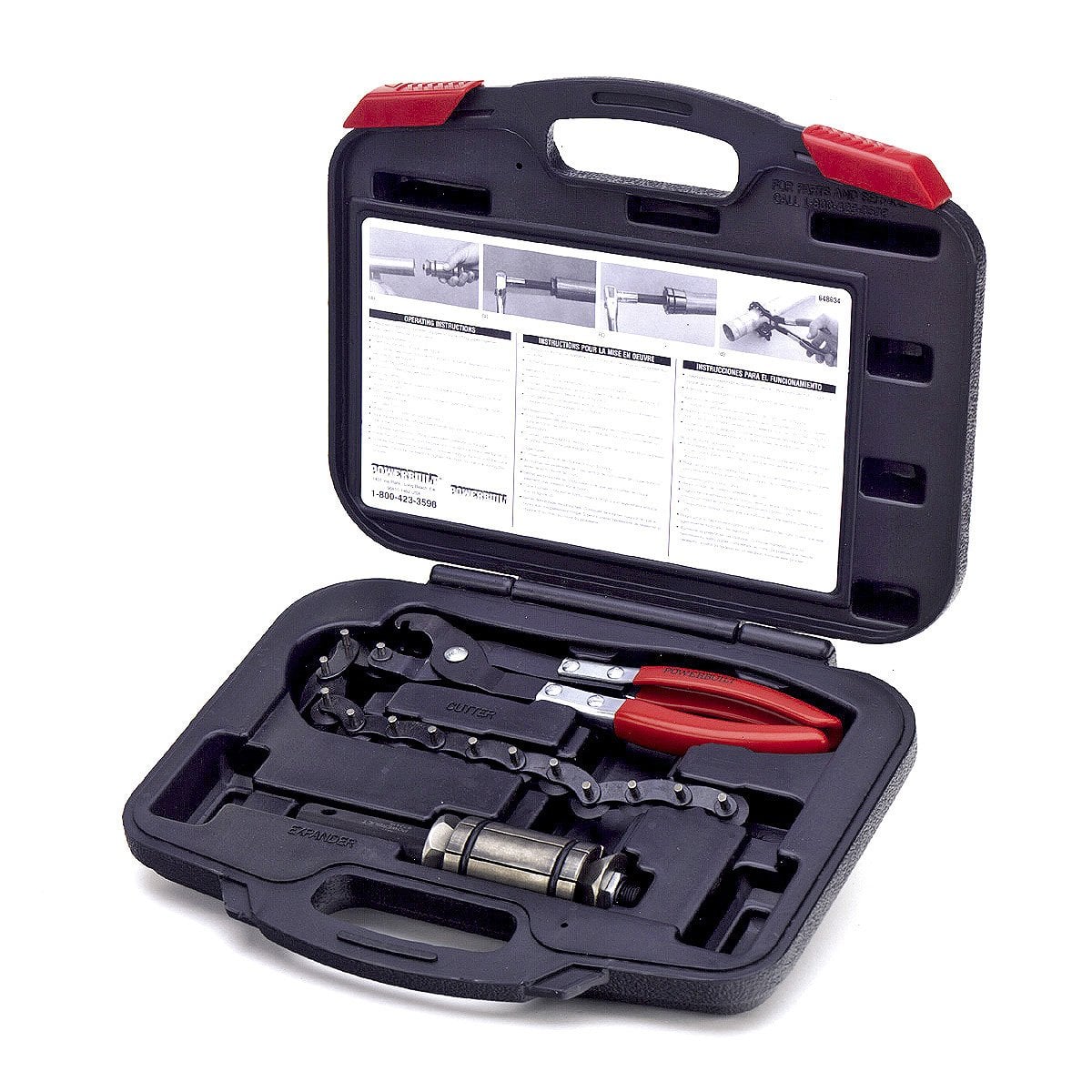

Editor’s Rating:
Features
The best part about his toolset is that it comes with a pipe expander as well. This alone gives you enough flexibility for any repair or replacement job on your car’s exhaust system. The set also includes a robust heavy-duty chain cutter that is capable of cutting up to 3-1/2 inch pipes.
The cutting wheels on the chain cutter are sharp straight out of the box for clean cuts and clean edges. Basically, the entire kit is designed to flare and expand exhaust pipes the way you need to for any job. You also get a high-quality case for storage which is great.
Verdict
At its price range, the Alltrade 648634 Kit is one of the toolsets you will need for every exhaust pipe cutting job. The pipe expander included in the set adds to the convenience you get with the unit. It also comes with a case that makes storage easy. With minimal effort, this pipe cutter will not just give you clean cuts but it will also help you remove the dents on your exhaust pipes.
Pros
- Comes with a case for storage
- Kit includes a pipe expander
- Cushioned handles for comfort
- It is ideal for heavy-duty cutting
Cons
- It’s not the best for cutting tight and hard to reach spaces
6. CTA Tools 2631 Tailpipe Cutter
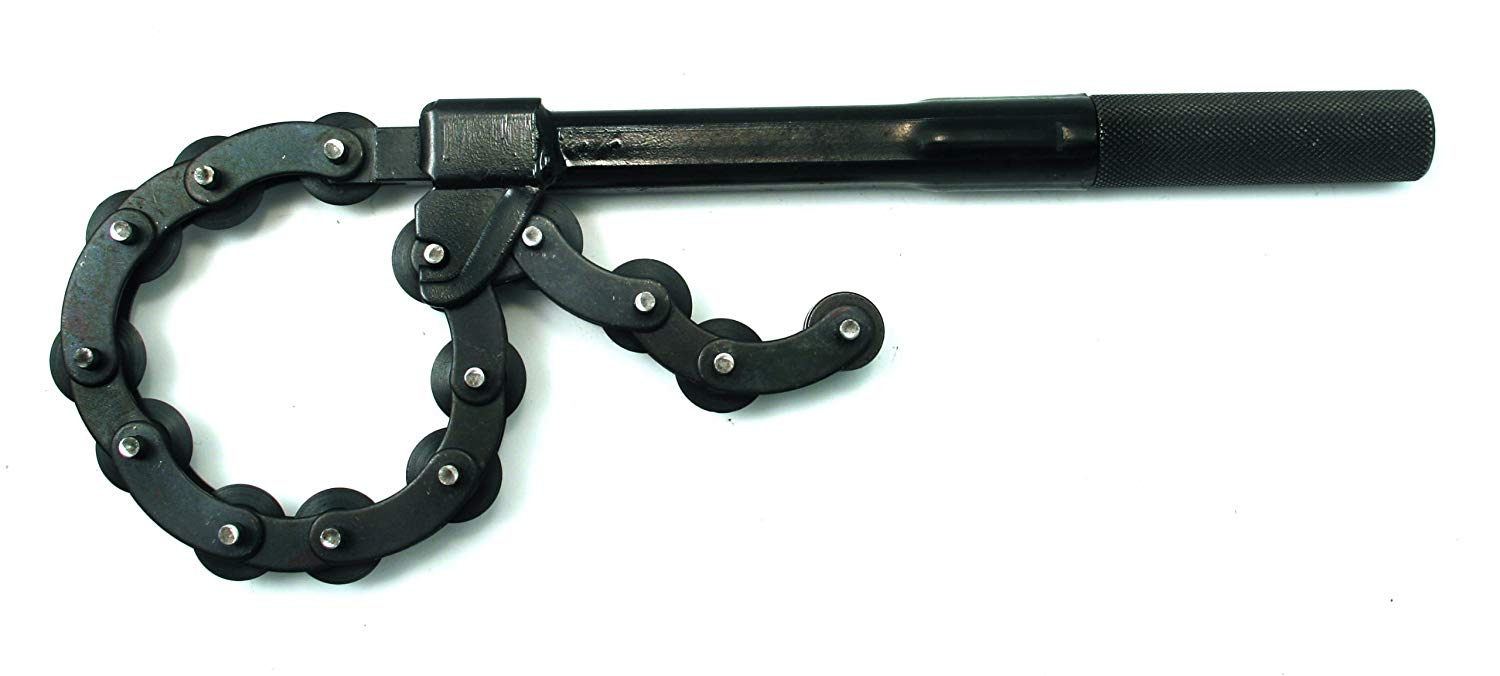

Editor’s Rating:
Features
The CTA Tools 2631 Tailpipe Cutter is unique since it comes with a carbide cutting wheel that makes it a decent tool for slicing heavy duty exhaust pipes. This tool will give you better performance than a hack saw plus it’s much safer since it won’t produce bits of hot metal that can cause injury.
While cutting, it is recommended that you take your time by first starting slow with slight pressure then increasing as the cuts get bigger. The tool can be used to cut pipes with an outer diameter of a ¾ inch to 3 inches. The pipe cutter is also capable of superior tracking thus allowing you to make clean cuts.
Verdict
This tool works great if you are looking for a fast cutting solution on your exhaust pipe. It is made for durability with carbide cutting wheels that provide superior tracking. However, there is no cushioning on its handle. All in all, it still performs well for DIYers looking for an affordable tool to use on their exhaust pipes.
Pros
- A great pick for superior tracking
- It can cut up to 3-inch diameter pipes
- Durable quality
- Designed for heavy duty tasks
Cons
- The handle lacks cushioning
7. Lisle 31500 Exhaust/Strut Cutoff Tool


Editor’s Rating:
Features
Sometimes all you need is a lightweight tool that gets you the most results from the least effort. If that is the case, you might want to go with the Lisle 31500 Exhaust/Strut Cutoff Tool.
It is designed for one hand operations making it easy to use especially on standard exhaust pipes.
It comes with four cutting wheels that are sharp enough to cut through a pipe whose diameter is in the 1-3/8 inch to 2-1/2 inch range. Considering its compact size and its lightweight build that is only 1.4 pounds heavy, this tool can be used to cut exhaust pipes in tight spaces without with minimal fatigue.
Its unique design also does a great job of achieving clean cuts. With just one hand and 1/3 hand turns, the Lisle 31500 Exhaust/Strut Cutoff Tool will help you cut around pipes better than a hacksaw.
Verdict
Apart from its unique one-handed design, this tool also comes in a skin pack. It’s a decent pick for making clean cuts on your exhaust pipes; however, it is not the best choice for cutting stainless steel pipes.
Pros
- Decent quality
- Easy one hand operation
- Ideal for cutting much closer to the mufflers
- Affordable
Cons
- Comes with a slight learning curve for beginners
- Not ideal for cutting stainless steel
8. Cal-Van Tools 764 Exhaust Tail Pipe Cutter
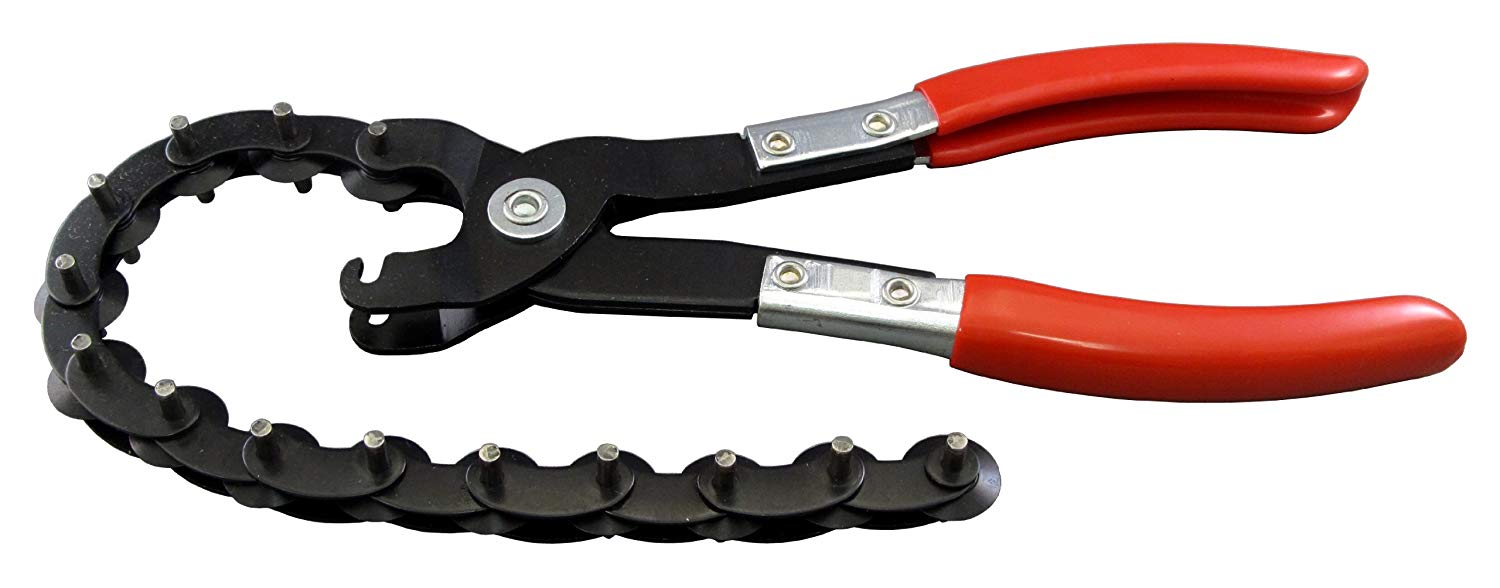

Editor’s Rating:
Features
This exhaust pipe cutter can cut through pipes with a diameter range from a ¾ inch to 3-1/4 inch with a ¼ turn.
It is ideal for cutting your exhaust pipe in tight and hard to reach spaces especially when you need to cut close to the muffler. It also comes with 19-millimeter cutting wheels that are able to cut deeply into any steel or aluminum pipes.
You also get a tool with cushioned handles for comfortable handling. The blades on the cutting wheel are designed to last meaning minimal maintenance on your side.
Verdict
Basically, the Cal-Van Tools 764 Exhaust Tail Pipe Cutter is a go-to exhaust pipe cutter for those who want to cut through heavy European type exhaust pipes. It has a capacity to cut through steel pipes making it ideal for heavy-duty cutting. It can also fit easily in tight and hard to reach places which is a plus.
Pros
- Lightweight build quality
- Durable design
- It can cut a 31/4 inch diameter
- Comfortable grip
Cons
- It’s not the best pick for fast cutting
9. Performance Tool W80664 Tail Pipe Cutter


Editor’s Rating:
Features
The Performance Tool W80664 Tail Pipe Cutter is built to last. It is made with a unique design that requires minimal effort to cut through exhaust pipes. All you have to do is twist the handle and scope it around the diameter of the pipe to adjust the handle while cutting.
At its core, the Performance Tool W80664 Tail Pipe Cutter is one-hand squeeze exhaust pipe cutter that cuts through pipes measuring between ¾ inches and 3-1/2 inch in diameter. Made with an adjustable 12-inch cutter chain, this exhaust pipe cutter can be useful for any repair or replacement jobs on your car’s exhaust system.
Verdict
There were some complaints about it not being able to cut through titanium or a double layer pipe. However, considering its price, this is a small drawback. Even though it’s not fit for heavy duty cutting, it can be handy for small DIY cutting projects.
Pros
- Reliable performance
- Ideal for lightweight DIY pipe cutting
- Features an easy to use twist handle design
- It has an adjustable 12-inch cutter chain
Cons
- It cannot cut through a double layer pipe
10. RATCHET EXHAUST PIPE CUTTER BY JTC 4039
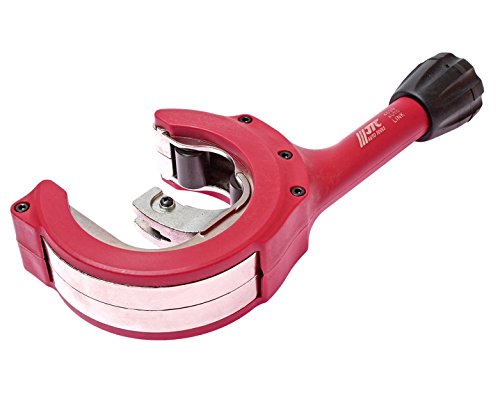

Editor’s Rating:
Features
In some situations, even an angle grinder won’t cut your exhaust pie the way you want. Basically, an angle grinder will end up producing sparks of hot metal pieces that can easily cause injury. Plus, it can be nearly impossible to cut pipes in hard to reach restricted areas.
For a solution, we suggest going with the RATCHET EXHAUST PIPE CUTTER BY JTC. This exhaust pipe cutter can cut pipes as thick as 3milimeters. It can be used to cut some of the toughest material including stainless steel.
To use it, slip the cutter on the shaft of the exhaust pipe you want to cut. Now turn the black handle clockwise in order to close the jaw of the cutter onto the pipe. After you have set it up with a tight grip, pull the black handle out and down to engage the ratchet and start cutting.
This tool is designed for minimal effort and maximum efficient cutting. With each revolution, you can tighten the jaws with a ¼ turn on the handle. This allows you to increase the cutting speed if you need to.
Verdict
This exhaust pipe cutter is a must-have for those who are looking for a tool that can cut through any metal or steel in the shortest time and with minimal effort. It comes with a design that is easy to use especially for beginner mechanics plus you can purchase extra blades separately which is great.
Pros
- Designed for safety
- Durable design
- It can cut through stainless steel
- Easy to use
- Ideal for fast cutting
Cons
- Spare blades are sold separately
FAQ
What is an exhaust pipe?
The entire exhaust system is usually made up of piping that expels the exhaust gases coming from combustion in the engine.Although different cars come with different exhaust designs, the entire system is made of pipes that exhaust the gas from the catalytic converter or the turbocharger to increase engine power. In some cases, the exhaust system might include a muffler to reduce the noise of the engine.
Will my car be ruined if I cut off the exhaust pipe?
The simple answer is no. However, you need to know that your exhaust pipe does more than just reduce the noise your car produces. Therefore you need to decide whether you are cutting the exhaust pipe to get a different sound with your muffler or to replace it with a suitable pipe. At its core, your exhaust pipe acts as a breathing system for your car. If you cut the exhaust pipe inappropriately, you might damage the exhaust system and your engine might not work well to get rid of the burnt fuel. If the exhaust fumes start to get into the passenger cabin, it can be dangerous for you and your passengers.
What is the best way to cut a steel pipe?
With an exhaust pipe cutter, you can easily cut through a steel pipe. Start by using a chalk to mark the line you plan to cut. Then use the chain to wrap a snap around the pipe according to the line you marked with a chalk. Now gently apply pressure to the handle of the pipe cutter while you twist back and forth to cut the pipe. Continue with this until the pipe cutter penetrates the steel pipe.
Will a new exhaust improve performance?
Yes, a new exhaust can improve your car’s engine performance. Basically, by adding a more efficient exhaust to your car, you enable uninterrupted flow of exhaust fumes and therefore give the engine more room for boosted horsepower and torque. A custom exhaust system can also improve the efficiency of your car’s fuel consumption.
Does exhaust affect speed?
Yes, the performance of your exhaust can affect the overall speed performance of your car. Here is how it works. When your engine’s exhaust flow is optimal, the rate at which your engine is able to take in more oxygen increases. Therefore, more combustion power is achieved in the engine. If you have a turbocharger installed, this can boost your speed even further. That is why sports car enthusiasts do not install mufflers to their exhaust system since the muffler tends to choke the exhaust system.
Guide to Buying the Best Exhaust Pipe Cutters
We have looked at some of the most important factors to have in mind before a purchase. Here are more factors to consider. We have also included some tips on how to use your pipe cutter with a look at the benefits of cutting your exhaust pipe.
Price
Price is one of the top considerations for any buyer out there and Just like any other product, exhaust pipe cutters come at different prices. The exhaust pipe cutters with the most basic features come at a cheaper price. These can be used for lightweight tasks such as cutting through thin metal pipes. They can also be used to cut through plastic pipes. However, when you are looking for a durable piece of equipment, the best option is to go with a slightly expensive exhaust pipe cutter. These types of exhaust pipe cutters tend to deliver much better quality in terms of performance plus they last longer.
Durability
Now that we have talked about price, how do you make sure the exhaust pipe cutter you bought is worth the money and durable enough. Well, first of all, an exhaust pipe cutter, unlike regular pipe cutters, needs to be tough enough to cut through the exhaust pipe which is made of an alloy of iron. That means that you should go with an exhaust pipe cutter that is equally made with a strong material capable of cutting through the iron pipe. For this reason, you need to go with a unit that has blades made of stainless steel. Stainless steel is more efficient at cutting through copper, brass and iron alloys without breaking a sweat. It’s also easy to maintain since it does not rust.
The material of the pipe cutter
Another factor that is closely related to the durability of your exhaust pipe cutter is the material used to make your pipe cutter. As mentioned earlier the best option is to go with an exhaust pipe cutter made with steel blades. However, you can also go with a unit made from an alloy of steel.
Regular maintenance
Like any tool with moving parts, exhaust pipe cutters also require regular maintenance to keep them durable while offering quality performance. Some of the basic maintenance tasks include oiling and cleaning the pipe cutter. Maintenance can get a bit costly especially if you are using the tool for commercial purposes. Even though it is easy to find an alternative to your tool’s maintenance, it is still a strong consideration
Tips for cutting through your exhaust pipe
So you are ready to start cutting through your exhaust pipe but you still need some more tips on how to do it right. Well, here are some of our safety tips that will help you get the job done fast.
- Choose your cutting tool wisely – We have looked at a variety of exhaust pipe cutters and their features. However, if you are on a tight budget yet you have a power saw lying around the house, you can still get the job done. However keep in mind that even though a power saw can be one of the cheapest ways to cut through your exhaust pipe, it can easily cause injury when the hot metal chips start to fly through the air. Another alternative to a pipe cutter is a handheld grinder. However, we recommend you stick to an exhaust pipe cutter since they are designed for safety as well.
- Use permanent markers and pipe wrappers – You need to create a reference line depending on the cuts you are looking to make. To achieve this, we recommend you use a permanent marker. You should also use a pipe wrap to achieve even more precision with your cuts.
- Take your time – If you are looking to get clean and easy cuts, you have to take your time with it. You also need to add some safety gloves and glasses to prevent any injuries from happening.
Benefits of cutting your exhaust pipe
Among most motorheads, one of the main reasons to cut your car’s exhaust pipe is to replace it with a straight exhaust pipe for better performance and pleasing aesthetics. Here is a breakdown of the reasons why you should cut your exhaust pipe.
- Pleasing aesthetics – After cutting your exhaust pipe, you can replace it with straight pipes that add to the aesthetics of your car especially if you apply a chrome finish to the tip of the exhaust. You can also use a variety of welding methods to add a touch of customization.
- Improved performance – This is by far one of the main reasons for cutting your exhaust pipe. Basically, by cutting your exhaust pipe and replacing it with a straight pipe you are able to reduce the pressure from your car’s engine thus allows the exhaust gases to flow freely. This can give your engine a boost in overall performance and horsepower.
- Engine sound – If you are going for that loud engine sound, the best way to do it (especially if you are on a budget) is to cut your exhaust pipe and replace it with a straight pipe exhaust. However, be careful not to wake up your entire neighborhood with the sound of your engine.
Despite the benefits of cutting your exhaust pipe to replace with a straight pipe exhaust system, there are also some cons. First of all, straight pipe setups are not only costly but also pretty loud. In some areas such as a suburban neighborhood, driving a loud car can warrant police attention. That is why loud exhausts are mostly reserved for racing cars. Basically, if you decide to straight pipe your car, you should be ready to deal with the consequences.
Conclusion
With our list of the best exhaust pipe cutters out there, there is no doubt that you will be able to find exactly what you need for the job. Whether you are cutting your car’s exhaust pipe for a repair job or to install straight pipe exhausts, getting the best exhaust pipe cutter can make the task much easier. When it’s all said and done, there is no denying that using an exhaust pipe cutter is way more efficient. These tools allow you to access tight spots plus they make it easy to achieve clean cuts with little or no burrs.
Source: Tools - autoquarterly.com


